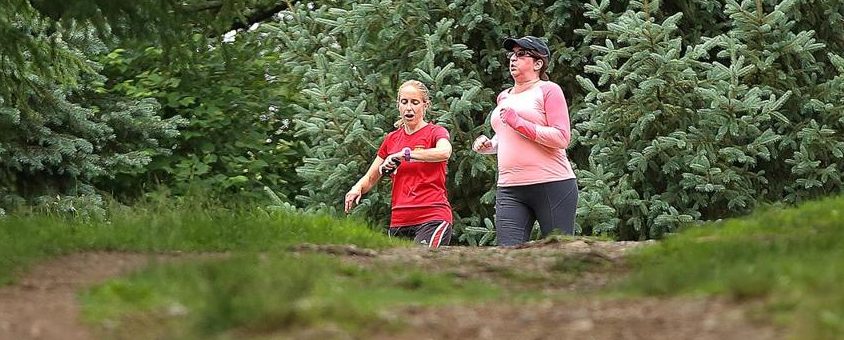Tips For Those Starting Running After 40
Rodrigo Martinez was inspired by reading about the ultra-endurance of a tribe of Mexican Indians in “Born to Run.” Gary Van Deurse was bored by walking. Therese Walsh wanted to improve her health.
All three made their moves around 40, lacing up their sneakers to run their way to better fitness.
Martinez now regularly races half-marathons after ditching a life consumed by business travel. Van Deurse hopes to run his first 5k in the fall. Walsh is already planning her running “homework” for her goal races later this year.
Starting to run with no prior experience comes with challenges at any age. But are there any special physical considerations for newbies who’ve crossed the threshold of 40?
Sports medicine specialists say yes and no. Yes, there are inescapable biological changes brought on by aging, but no, they shouldn’t stop you, unless you run into injury trouble.
Dr. Jeffrey Zilberfarb, an orthopedic surgeon at Beth Israel Deaconess Medical Center and New England Baptist Hospital, thinks exercise of any kind is particularly important for people after 40. More than a decade of scientific studies have shown physical activity rivals any drug for improving cardiovascular health, bone strength, and mental health. As people age, he argues, exercise becomes even more critical to counteracting natural decline.
“We never lose the ability to train and to get stronger,” Zilberfarb said. “Anyone can get into shape, assuming your heart and your lungs are good. You can always do something.”
As early as age 30 our bodies start to lose muscle mass at the rate of 1 percent per year. Exercise can’t completely stem that slide, but it can slow it. Some elderly people have trouble lifting themselves out of a chair, but others in their 70s are still running marathons, thanks to regular training — not solely because they won the genetic lottery.
With aging, tendons and ligaments lose water in their collagen, making them less flexible and more likely to tear. Discs in the back get stiffer. Bones become more brittle. Aerobic capacity diminishes. Metabolism slows.
But exercise changes bodies both young and old. The “good” stress of training makes muscles stronger and bones thicker. Exercise also boosts the number of mitochondria, the powerhouses of the cell. And fitter bodies make better use of glucose, the cell’s fuel. As an added benefit, physical activity elevates mood, decreasing both anxiety and depression.
There are risks, however. J. Alex McKinney, director of services at Marathon Physical Therapy and Sports Medicine in Newton, says it is important that older runners understand the stress running places on the body. For starters, each foot hammers the ground 300 to 500 times per mile at a force of up to three times your body weight. Age reduces stride length, leg strength, and aerobic capacity, he says, so he recommends getting a biomechanical assessment of risk for injury.
Furthermore, Zilberfarb warns, forget the old mantra “no pain, no gain.” Do not run through pain, especially if you are older. Pay attention to pain that does not go away. It could be a stress fracture that, with a little time off, won’t be debilitating. If your hamstring is screaming, give it time to heal.
Constant joint pain should send you to a health provider’s office. Running doesn’t cause osteoarthritis, multiple studies have shown, but if you are among the majority of people who develop the degenerative disease of cartilage and bone after 40, it might be time to consider a lower-impact activity, such as cycling or swimming.
All new runners — including anyone who hasn’t run for years — should start out easy, experts say. Build up mileage or minutes gradually, at a rate of about 10 percent a week. Get some sleep and eat good food.
“Eating a well-balanced diet with plenty of water throughout the day is important for energy levels, blood flow, and tissue mobility, followed by eight hours of sleep to help release growth hormones within the body to accelerate the tissue-healing process,” McKinney said.
For Walsh, 45, it’s her second time joining a weekly Couch to 5K class, both run as wellness initiatives by her employer, Hebrew Senior Life. Members methodically mix walking and running over several weeks until they can run the entire 3.1 miles.
Unlike her attempt two years ago, Walsh has been faithfully running three times a week between sessions — her homework — to maintain her fitness. Despite back surgery for a disk problem, arthritis in her knee, and exercise-induced asthma, she still feels better after she runs.
“The nights I run after I get home from work, I have more energy left over to do small chores that I normally would put off,” she said. “I know I was worse when I didn’t do anything.”
Van Deurse, 41, is wary of injury, with the memory of hurting his arm clearing ice dams last winter still fresh in his mind. But he wanted something more strenuous than daily walks. He gradually upped his game from running one mile on his own in April to a high of four miles in June.
“I definitely feel better. My weight hasn’t changed a lot, but I feel stronger and leaner,” he said. “I just bought a pair of pants and I went down a size.”
Martinez, 43, took as a challenge a doctor telling him as a child that his flat feet meant no running. Growing up in Mexico, Martinez played volleyball and soccer but never considered running until he turned 39.
He wasn’t sleeping well; his weight was creeping up; and he knew he needed to change.
When he read Christopher McDougall’s tale of the Tarahumara people running barefoot through the rocky canyons of Mexico, he took it to heart.
“My body compared to my 20s is not in as good shape, but compared to my 30s, I’m in much better shape,” he said. “I have to make more of an effort and be more deliberate about what I’m doing. But I’m healthier now.”
By Elizabeth Cooney
Originally posted on Globe.com July 17, 2015




